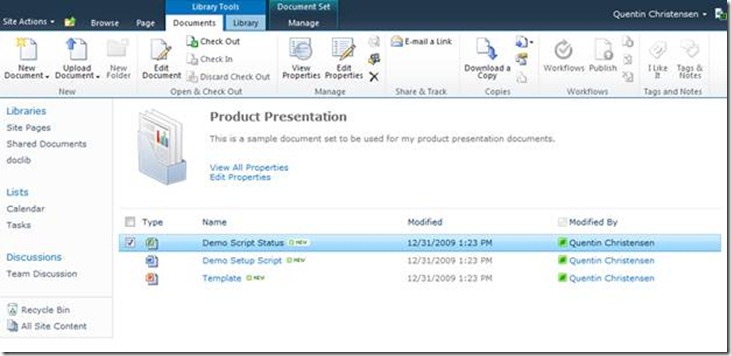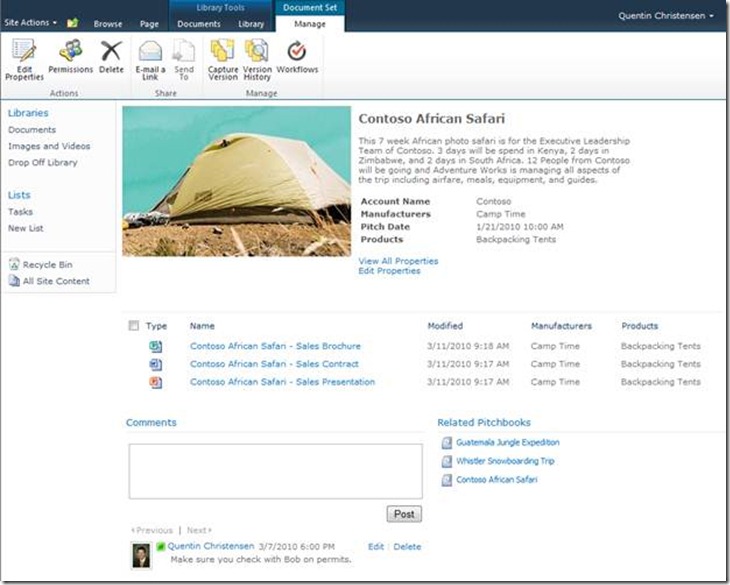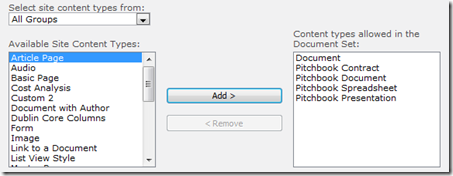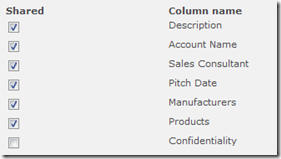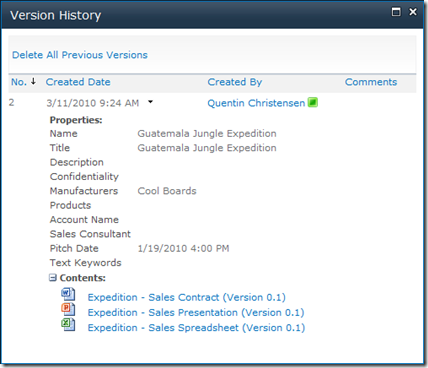Introducing Document Sets
Hi there, this is Quentin again. In today’s post I would like to introduce an exciting new content type that is used as an architectural component for organizing multi document based work products. Document sets fit between documents and sites. You can use document sets when you have a group of related documents to collaborate on, but don’t need an entirely new document library or site. Document sets provide a collaborative workspace where users can work on a related group of documents. Since the release of SharePoint 2010, I have seen document sets being used for a wide variety of scenarios internally here at Microsoft and with some of our customers. Some examples include research projects, software development specifications, knowledge management repositories, and usability studies.
Document sets are similar to folders, but when you access a document set you get a web part page that can be customized. When you upload documents to a document set they are displayed in a web part that works just like a document library view. Several document set features make it faster and easier to work on projects of related documents. Here are a few of these features:
- Shared metadata enforces the same metadata on all items inside the document set
- Default documents can be automatically provisioned when a document set is created
- A web part page called the welcome page displays the contents of the document set and can also be customized to display more information than just documents
Document sets fit in with our overall document management vision by helping manage the unmanaged and bringing collaboration and metadata into document creation and management. Document sets can be used to organize and find content and they make it easy to group and relate documents. Document sets encourage using columns for metadata on the document set itself and the documents within. Shared columns put document set metadata on all of the documents inside and it is useful to display the properties of the document set on the document set welcome page. Document sets make it faster and easier to work on groups of related documents, saving time and money.
We built document sets based on scenarios that we saw both internally at Microsoft and from our customers. For example on the Office team we organize the parts of the products we build into features and each feature has a team that works on it. These features have specifications, development plans, and test plans. Document sets make it easier to create the necessary documents and manage a collection of documents for a feature.
We also saw customers with similar scenarios, such as sales proposals that require presentations, spreadsheets, and sales contracts. Rather than manage each item individually, in these cases there may be metadata that should be shared and workflow processes that should happen on the collection of items. We expect partners and customers to take document sets and customize them for specific vertical scenarios to support important processes such as managing cases and research projects.
Now that I have given a quick intro into what document sets can be used for, allow me to give an overview of the main features of document sets.
Welcome Page
When you go to a document set you will notice that it isn't your typical folder view. Document sets have a customizable welcome page. By default this page has a document set properties web part. From the document set settings page of the content type you can specify which document set columns show up in this web part. There is also a Document Set Contents web part which displays the documents that have been added to the Document Set.
This is an example of a non-customized document set welcome page with a few documents.
This is an example of a customized welcome page that has had the image changed and a note board added. The welcome page is shared by all document sets of a particular content type in a list so any changes will be reflected for all instances. This makes it fast and easy to make changes to the welcome page because the updates will be instantly available to existing document sets.
Allowed Content Types
You can select the content types that are available to the document set, allowing you to control the types of content that are available to be used inside the document set.
Default Content
Documents can be specified to be automatically created when a new document set is created. Default documents can be specified, allowing you to control the templates people use for a document set. This saves the time of having to find and upload templates to get started with. Of course users can still upload their own documents to a document set as well.
Shared Columns
Document set columns can be shared to all the documents inside the document set. This will make the column read only so the value can only be changed by editing the properties of a document set. This saves users time because they only need to update metadata in one place and it will then be updated on all documents inside the document set. It also helps ensure that metadata is consistent. You can use shared columns to make sure all of the documents have certain metadata.
Send To
Send To locations that have been specified in Central Administration will be available to document sets so you can send them to a configured content organizer. You can also use workflow actions to send document sets to a content organizer. The content organizer is a new SharePoint 2010 feature for moving content based on metadata to folders, libraries, or other sites.
Customizable Ribbon
One of the major improvements with SharePoint 2010 is the ribbon interface that is similar to the ribbon interface used in the Office client applications. Document sets have their own ribbon to perform actions such as send to, delete, and capturing versions. This ribbon can also be customized to add new commands.
Versioning
Document sets have their own versioning that is used to capture a snapshot of checked in versions of documents and the properties of the document set.
Workflow
Document sets support workflows on a collection of documents. Several workflow actions specific to the document set are available in SharePoint Designer including capture a version and start an approval process.
Summary
Document sets are a great way to organize related documents for project based work. They provide a customizable and collaborative environment that you can use to meet the needs of multi document work products. They are also a central information architecture component that can be used to represent concepts such as research notebooks, sales proposals, and product specifications. Document sets make it easier to automatically provision templates, collaborate on a group of documents, and share information about documents (such as metadata properties).
Be sure to subscribe to the ECM blog RSS feed and keep reading the blog. I will be posting more blog posts about document sets where I will cover creating a custom document set content type and customizing the welcome page.
Quentin Christensen
Program Manager, Document and Records Management
